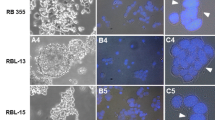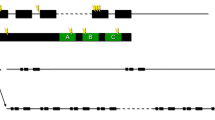Abstract
Retinoblastoma (RB) is a childhood eye tumor, caused by the RB1 gene mutation. Since RB is a rapidly proliferating tumor, the patient presents with a Group-D/E tumor at the time of diagnosis. Enucleation is preferred in most unilateral cases to prevent metastasis. Various cell lines have been established to study the tumor’s growth pattern and target the cancer cells. The commonly used cell lines are WERI-Rb-1 and Y79, both isolated from the primary tumor of RB. Cell lines established from the metastatic site of RB have not been characterized before. In this study, we have characterized NCC-RbC-51, derived from RB tumor to cervical lymph node site and investigated its potential to represent a highly aggressive and metastatic tumor. We compared the proliferative and invasive properties of NCC-RbC-51 with a cell line isolated from the primary site, WERI-Rb-1. NCC-RbC-51 had higher rates of proliferation and apoptosis and had better invasive ability. Copy number variation analysis and the pathways predicted from these show that the pathways altered in NCC-RbC-51 could contribute to its metastatic nature. In all, the results suggest that NCC-RbC-51, a cell line isolated from metastatic site, could be a potential model to study aggressive/invasive RB.




Similar content being viewed by others
References
Abramson DH, Schefler AC, Beaverson KL, Rollins IS, Ruddat MS, Kelly CJ (2002) Rapid growth of retinoblastoma in a premature twin. Arch Ophthalmol 120(9):1232–1233
Beresford MJ, Wilson GD, Makris A (2006) Measuring proliferation in breast cancer: practicalities and applications. Breast Cancer Res 8(6):216. https://doi.org/10.1186/bcr1618
Busch M, Philippeit C, Weise A, Dunker N (2015) Re-characterization of established human retinoblastoma cell lines. Histochem Cell Biol 143(3):325–338. https://doi.org/10.1007/s00418-014-1285-z
Chevez-Barrios P, Hurwitz MY, Louie K, Marcus KT, Holcombe VN, Schafer P et al (2000) Metastatic and nonmetastatic models of retinoblastoma. Am J Pathol 157(4):1405–1412. https://doi.org/10.1016/S0002-9440(10)64653-6
Collett K, Eide GE, Arnes J, Stefansson IM, Eide J, Braaten A et al (2006) Expression of enhancer of zeste homologue 2 is significantly associated with increased tumor cell proliferation and is a marker of aggressive breast cancer. Clin Cancer Res 12(4):1168–1174. https://doi.org/10.1158/1078-0432.CCR-05-1533
Conkrite K, Sundby M, Mukai S, Thomson JM, Mu D, Hammond SM, MacPherson D (2011) miR-17 ~ 92 cooperates with RB pathway mutations to promote retinoblastoma. Genes Dev 25(16):1734–1745. https://doi.org/10.1101/gad.17027411
da Huang W, Sherman BT, Lempicki RA (2009a) Bioinformatics enrichment tools: paths toward the comprehensive functional analysis of large gene lists. Nucleic Acids Res 37(1):1–13. https://doi.org/10.1093/nar/gkn923
da Huang W, Sherman BT, Lempicki RA (2009b) Systematic and integrative analysis of large gene lists using DAVID bioinformatics resources. Nat Protoc 4(1):44–57. https://doi.org/10.1038/nprot.2008.211
Deng Z, Matsuda K, Tanikawa C, Lin J, Furukawa Y, Hamamoto R, Nakamura Y (2014) Late Cornified Envelope Group I, a novel target of p53, regulates PRMT5 activity. Neoplasia 16(8):656–664. https://doi.org/10.1016/j.neo.2014.07.008
Desai SS, Jambhekar NA (2010) Pathology of Ewing’s sarcoma/PNET: current opinion and emerging concepts. Indian J Orthop 44(4):363–368. https://doi.org/10.4103/0019-5413.69304
Evan GI, Wyllie AH, Gilbert CS, Littlewood TD, Land H, Brooks M et al (1992) Induction of apoptosis in fibroblasts by c-myc protein. Cell 69(1):119–128
Fabregat A, Jupe S, Matthews L, Sidiropoulos K, Gillespie M, Garapati P et al (2018) The reactome pathway knowledgebase. Nucleic Acids Res 46(D1):D649–D655. https://doi.org/10.1093/nar/gkx1132
Gallie BL, Campbell C, Devlin H, Duckett A, Squire JA (1999) Developmental basis of retinal-specific induction of cancer by RB mutation. Cancer Res 59(7 Suppl):1731s–1735s
Honavar SG, Singh AD (2005) Management of advanced retinoblastoma. Ophthalmol Clin N Am 18(1):65
Huang J, Zhang L, He C, Qu Y, Li J, Zhang J et al (2015) Claudin-1 enhances tumor proliferation and metastasis by regulating cell anoikis in gastric cancer. Oncotarget 6(3):1652–1665. https://doi.org/10.18632/oncotarget.2936
Inomata M, Kaneko A, Saijo N, Tokura S (1994) Culture of retinoblastoma cells from clinical specimens: growth-promoting effect of 2-mercaptoethanol. J Cancer Res Clin Oncol 120(3):149–155. https://doi.org/10.1007/bf01202193
Ito Y, Miyauchi A, Yoshida H, Uruno T, Nakano K, Takamura Y et al (2003) Expression of alpha1,6-fucosyltransferase (FUT8) in papillary carcinoma of the thyroid: its linkage to biological aggressiveness and anaplastic transformation. Cancer Lett 200(2):167–172
Jia D, Jing Y, Zhang Z, Liu L, Ding J, Zhao F et al (2014) Amplification of MPZL1/PZR promotes tumor cell migration through Src-mediated phosphorylation of cortactin in hepatocellular carcinoma. Cell Res 24(2):204–217. https://doi.org/10.1038/cr.2013.158
Kang SJ, Grossniklaus HE (2011) Rabbit model of retinoblastoma. J Biomed Biotechnol 2011:394730. https://doi.org/10.1155/2011/394730
Kaur G, Dufour JM (2012) Cell lines: valuable tools or useless artifacts. Spermatogenesis 2(1):1–5. https://doi.org/10.4161/spmg.19885
Kivela T, Tarkkanen A, Virtanen I (1989) Synaptophysin in the human retina and retinoblastoma. An immunohistochemical and Western blotting study. Invest Ophthalmol Vis Sci 30(2):212–219
Magalhaes A, Duarte HO, Reis CA (2017) Aberrant glycosylation in cancer: a novel molecular mechanism controlling metastasis. Cancer Cell 31(6):733–735. https://doi.org/10.1016/j.ccell.2017.05.012
Manning AL, Longworth MS, Dyson NJ (2010) Loss of pRB causes centromere dysfunction and chromosomal instability. Genes Dev 24(13):1364–1376. https://doi.org/10.1101/gad.1917310
Marshall J (2011) Transwell((R)) invasion assays. Methods Mol Biol 769:97–110. https://doi.org/10.1007/978-1-61779-207-6_8
Massberg D, Jovancevic N, Offermann A, Simon A, Baniahmad A, Perner S et al (2016) The activation of OR51E1 causes growth suppression of human prostate cancer cells. Oncotarget 7(30):48231–48249. https://doi.org/10.18632/oncotarget.10197
McFall RC, Sery TW, Makadon M (1977) Characterization of a new continuous cell line derived from a human retinoblastoma. Cancer Res 37(4):1003–1010
Mehner C, Hockla A, Miller E, Ran S, Radisky DC, Radisky ESJO (2014) Tumor cell-produced matrix metalloproteinase 9 (MMP-9) drives malignant progression and metastasis of basal-like triple negative breast cancer. Oncotarget 5(9):2736
Su S, Gao J, Wang T, Wang J, Li H, Wang ZJTB (2015) Long non-coding RNA BANCR regulates growth and metastasis and is associated with poor prognosis in retinoblastoma. Tumor Biol 36(9):7205–7211. https://doi.org/10.1007/s13277-015-3413-3
Tester AM, Ruangpanit N, Anderson RL, Thompson EWJC (2000) MMP-9 secretion and MMP-2 activation distinguish invasive and metastatic sublines of a mouse mammary carcinoma system showing epithelial-mesenchymal transition traits. Clin Exp Metastasis 18(7):553–560
Wang X, Chen J, Li QK, Peskoe SB, Zhang B, Choi C et al (2014) Overexpression of alpha (1,6) fucosyltransferase associated with aggressive prostate cancer. Glycobiology 24(10):935–944. https://doi.org/10.1093/glycob/cwu051
Yeh YT, Dai HY, Chien CY (2014) Amplification of MPZL1/PZR gene in hepatocellular carcinoma. Hepatob Surg Nutr 3(2):87–90. https://doi.org/10.3978/j.issn.2304-3881.2014.02.06
Acknowledgements
We would like to acknowledge the Department of Biotechnology, India for funding the work (EXOSOMAL microRNA AS BIOMARKERS OF EARLY AND LATE STAGE RETINOBLASTOMA BT/PR8606/AGR/36/781/2013). We would like to acknowledge Dr. Masako Inomata, the originator of the NCC-RbC-51 cell line.
Author information
Authors and Affiliations
Corresponding author
Ethics declarations
Conflict of interest
All authors declare that they have no conflict of interests.
Additional information
Publisher's Note
Springer Nature remains neutral with regard to jurisdictional claims in published maps and institutional affiliations.
Electronic supplementary material
Below is the link to the electronic supplementary material.
418_2019_1832_MOESM3_ESM.tif
The untreated and Annexin PI stained RB cell lines, WERI-Rb-1 (B) and NCC-RbC-51 (A) showing the apoptotic profile of the two cell lines. (Q1 - Dead cell population, Annexin V–PI + , Q2 - Late apoptotic population, Annexin V + PI + , Q3 - Non-apoptotic population, Annexin V– PI–, Q4 - Early apoptotic population Annexin V + PI–) (TIFF 257 kb)
Rights and permissions
About this article
Cite this article
Ravishankar, H., Mangani, A.S., Shankar, M.B. et al. Characterization of NCC-RbC-51, an RB cell line isolated from a metastatic site. Histochem Cell Biol 153, 101–109 (2020). https://doi.org/10.1007/s00418-019-01832-1
Accepted:
Published:
Issue Date:
DOI: https://doi.org/10.1007/s00418-019-01832-1




